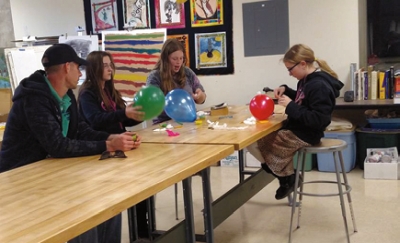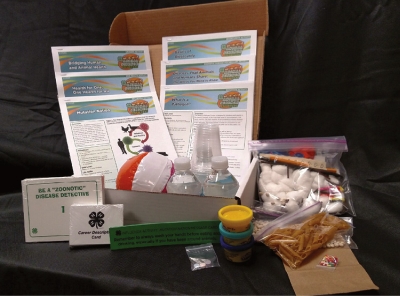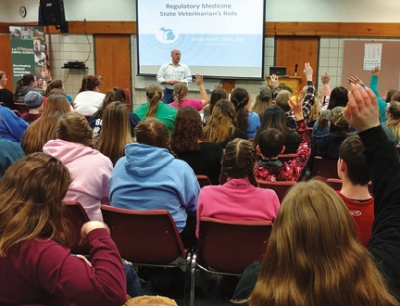Preventing the Spread of Zoonotic Disease

Signs inform fair-goers about the best ways to prevent the spread of zoonotic disease.
- James Averill
- State of Michigan Veterinarian
- Michigan Department of Agriculture and Rural Development
- Julie Conover
- 4-H Livestock and Veterinary Science Educator
- Michigan State University Extension
Each year in Michigan, more than 80 fairs are held featuring animal exhibitions—this includes county fairs, community fairs, and 4-H fairs. Many feature carnival rides and games, tractor pulls, and monster trucks. Others offer an opportunity for young people and agriculturists to show off their skills in the animal arena. This adds up to thousands of visitors pouring into fairgrounds across the state. At some point, many make their way to the livestock barns to see rabbits, roosters, and rams. There might even be a petting zoo where children get up close and personal with animals they may only know from the Fisher-Price farm back home.

4-H'ers create models to explore the various germs that infect humans and animals.
While fun and educational, those up-close-and-personal interactions are also an opportunity for humans and animals to swap germs—both animals to people and people to animals. Even after the initial exchange, these germs continue their travels as animals and humans make their way back to their respective homes and barns after the event—spreading the germs much farther than the fair.
Because of this opportunity for germ transfer, biosecurity has become an important topic for those who care for livestock and those who manage fairs and exhibitions. Thanks to a collaboration between Dr. James Averill, Michigan's state veterinarian (an office housed in the Department of Agriculture and Rural Development; MDARD), and MSU Extension, thousands of 4-H children and youth and others understand the risk of zoonotic disease—any disease that can affect both animals and people—and have been trained in best practices for preventing germ and disease spread. Now when they bring animals to show at the fair, they are aware of their role in helping to fight the spread of germs.
Targeting children and youth with this education and training campaign was not accidental. The Center for Disease Control and Prevention and the Center for State and Territorial Epidemiologists had already been educating adults working with livestock on these issues. However, youth biosecurity education was not consistently covered. So the organizations put together a grant to fund outreach to this group, focusing on the state's leading youth development program—MSU Extension's 4-H—to reach this critical audience.
The Campaign
 Leading the grant effort was MSU Extension 4-H livestock educator Julie Conover. The first piece she developed was an educational toolkit, which was shipped out to 4-H clubs around the state. She had anticipated that they would need about 900 kits to fill demand, but closer to 2,000 were requested by 4-H groups as they eagerly looked for educational resources on the topic. Each kit contained activities that introduced kids to zoonotic disease and how they could implement best practices to avoid zoonotic disease transfer.
Leading the grant effort was MSU Extension 4-H livestock educator Julie Conover. The first piece she developed was an educational toolkit, which was shipped out to 4-H clubs around the state. She had anticipated that they would need about 900 kits to fill demand, but closer to 2,000 were requested by 4-H groups as they eagerly looked for educational resources on the topic. Each kit contained activities that introduced kids to zoonotic disease and how they could implement best practices to avoid zoonotic disease transfer.
"The program grew from a pilot program that Julie Conover adapted from the University of Georgia," Averill said. "I showed it to my staff, who really wanted to get involved, and the project was expanded with help from the Michigan Department of Health and Human Services (DHHS). Julie got a grant from the CDC to increase outreach, and it's been very successful in educating youth about the role of bacteria in animals and humans."

Students learn about the tools needed for working safely with animals.
The plans, activities, and handouts in each kit were organized into three lessons: What is a Pathogen; Diseases: Words You Need to Know; and Basics of Biosecurity. Children used Play-Doh to make models of viruses, bacteria, and parasites to understand their relative sizes. A matching card game helped kids identify certain pathogens.
 Averill and Conover also spoke to various audiences, like the Michigan Association of Fairs and Exhibitions and MSU Extension's 4-H program coordinators, about the importance of biosecurity.
Averill and Conover also spoke to various audiences, like the Michigan Association of Fairs and Exhibitions and MSU Extension's 4-H program coordinators, about the importance of biosecurity.
Another prong of the program was the signage campaign. Posters and banners were designed to reinforce the lessons taught through 4-H and inform the public about the importance of hand washing, not eating in the livestock areas, etc. These signs have gone out to fairs and exhibitions and the Michigan State University south campus farms.
The initial grant was $20,000. When that expired, the CDC stepped forward with another $75,000 to expand the program's reach and impact. Some of those resources are being used to simply do more of what's been done already, but the team is also looking at ways to make the education more effective. For example, they are now distributing biosecurity kits with disposable gloves, disposable boots, and hand sanitizer.

Toolkits were used by 4-H groups across the state to teach kids about zoonotic disease.
Indicators of Progress
Two years into the effort, Averill points to impacts he has seen grow out of this partnership, in terms of benefits to public health and to his own work.
"The most valuable thing is that we're raising awareness," he said, "getting youth thinking about biosecurity and empowering them to take the initiative and put good biosecurity practices in place for their project. Additionally, they influence their parents, which further increases knowledge and awareness about biosecurity."
"This is a strong partnership because we draw on each other's strengths," he said. "We collaborate, not only with our scientific experts, but with how we effectively get messages out to fair personnel, exhibitors, and veterinarians."
Another benefit highlighted by Averill and Conover is the network that has been created around biosecurity.
"This past year provided some 4-H youth and fair personnel with an opportunity to put their biosecurity education into practice," said Conover. "We had a few fairs that had swine influenza outbreaks and, because of the close partnership and working relationship between MSU Extension, MDARD and DHHS, as well as the diligent biosecurity practices our fairs and 4-H'ers had implemented, we were able to keep those outbreaks to a minimum."

Dr. Averill talks to a group of students.
Partnering With Michigan State University
This isn't Averill's first partnership with the University. His office in MDARD and Michigan State University collaborate often.
His office has worked closely with the MSU Veterinary Diagnostic Laboratory and the College of Veterinary Medicine on bovine tuberculosis. They have worked with the MSU Product Center at the College of Agriculture and Natural Resources to answer economic questions. The Department of Animal Science has also been a reliable resource. "Their expertise helps us with livestock issues. I'm on their advisory committee," Averill said.
Addressing faculty who might be open to partnering with the community, Averill observed: "There are always opportunities to help. Just be present, doing what you do best—ask questions, be a listening ear. New partnerships can result. I like that old quote, ‘The world is run by those who show up.' So be out there. Make that connection."
- Written by Matt Forster, University Outreach and Engagement